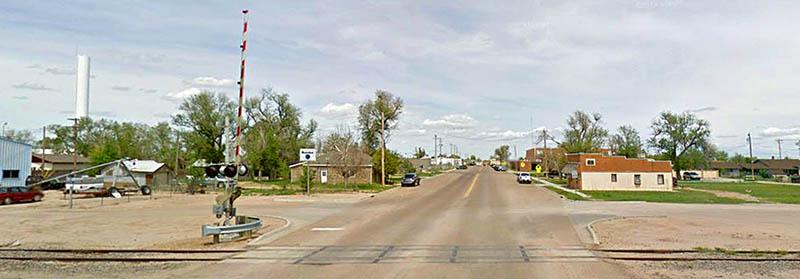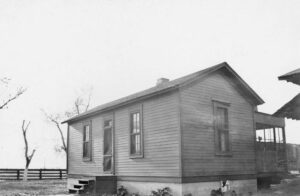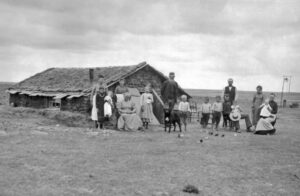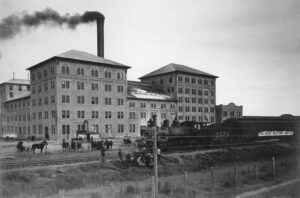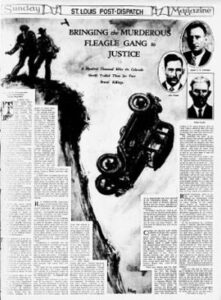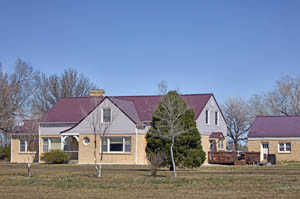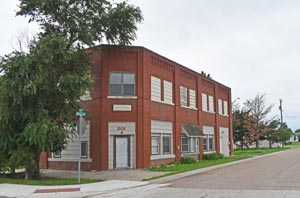Holcomb, Kansas, in Finney County, is a small town on the Arkansas River west of Garden City. As of the 2020 census, the population of the city was 2,245.
This community got its start in 1872 when it was first called Sherlock in honor of Thomas Sherlock, Sr., a director of the Atchison, Topeka & Santa Fe Railroad. The railroad determined that the location would be the proper distance from their station in Pierceville. Sherlock was intended to be the prominent town in Finney County. It was established in what was then Sequoyah County.
In 1878, the town had a siding, a section house, and a water tank. A post office was established on October 24, 1878. It was only a flag station, but mail was thrown off there for Garden City, which the railroad company refused to recognize as a station. A schoolhouse was built that year, and the community boasted a general store, restaurant, and other businesses.
H. Porter had a horse ranch south of the river with headquarters in a dugout near the section house, and section crews worked in and out of Sherlock, but there were no permanent residents there until early in the spring of 1879. During that spring, several people came from the east to take up the government land or to buy from the railroad company. A.F. Lee and family from New York were among the first to settle at Sherlock. Upon their arrival, there was nothing there but a section house, and they and some other families lived in it until lumber was shipped in to build a shelter on their claims. James Mangan and family, W. R. Hopkins and family, and the John Calhoun family were among the earliest settlers.
By May 1879, Spencer and Company were operating a store; J.E. Woods and Company had shipped in lumber to start a yard; Thomas Julian had a restaurant and bakery; J.H. Holmes ran the section boarding house; George Igou was doing a land-agent business, and by July the town had a saloon, called the “Hoo Doo Shop.”
Sherlock flourished in the beginning. However, Garden City made every effort to be the city in the valley. They offered to move the Sherlock citizens, buildings and all, free of charge if they would locate in Garden City, and most of them took advantage of the offer.
The seasons that followed were hot, dry, and windy, and Sherlock and the country which had been so recently taken up was deserted of all except the cowboys and a few determined settlers. One resident who stayed in the area said that days would pass without seeing signs of life except for the trains leaving the station or the range stock and wild animals running down to the river to quench their thirst.
The post office closed on August 19, 1880.
The Porter horse ranch was bought out by Fred Harvey in 1881, and Major Falls had charge of the cattle, which were driven down from Wallace, Kansas. S.H. Corbett was a cowboy on the X Y Ranch. The headquarters were at Lakin, but Mr. Corbett said the boys always liked to eat at the section boarding house at Sherlock because they put out good meals. They sank barrels in the river and kept them stocked with fish for table use, and they always had fresh river trout, bass, and catfish to serve their guests.
Sherlock built its first schoolhouse in 1883. About 18-20 families were in the neighborhood, and they all donated money to buy the lumber and did the carpenter work themselves. Subscriptions financed it. The one-room school was large enough to be used for church and Sunday school.
About that time, Sherlock began to show signs of prosperity again, and a post office was reestablished on December 6, 1883, with John W. Gregory as the postmaster. According to the Garden City Irrigator newspaper of January 3, 1884, “It will be kept at present in the section house and will be a great convenience to the people in that part of the county.”
In 1885, after Finney County was organized and school districts began to be formed, Sherlock built the first district schoolhouse in the county. It was a large-frame building, and the indebtedness was paid before the first school was held.
In the Sherlock items in the Garden City Irrigator of March 6, 1886:
“The new station building on the railroad is completed, and a new store building will be erected. The contract is let for the new bridge across the Arkansas River, and various lines of business will open soon.”
James A. Barkley was appointed postmaster on April 26, 1886. The post office was discontinued at Sherlock on April 15, 1890, and mail for that office was sent to Garden City. The Sherlock post office was reestablished on July 6, 1899. However, it closed again on January 31, 1901.
When the Garden City Company’s Sugar Beet Factory was built at the west edge of Garden City in 1906, things began to turn back around for Sherlock.
On December 3, 1909, the post office was reestablished, and the name was changed to Holcomb in honor of D.C. Holcomb, a local rancher who was very active in developing that part of Finney County. The town was platted, and many lots were sold.
In 1910, Holcomb was still a station on the Atchison, Topeka & Santa Fe Railroad and was a trading point for the neighborhood. At that time, its population was 75.
H.C. Wiley started the Holcomb State Bank in 1912 at the corner of Main Street and Douglass Avenue. The bank was robbed at least twice during its operation. The first was in 1917, when $1,500 was taken. In 1930, the Fleagle Gang robbed the bank the second time.
That year, Holcomb was famed as having the largest consolidated school in the state. It was composed of six districts containing 125 square miles.
The school grounds consisted of seven buildings, besides an athletic field and a first-class farm of 12 acres, equipped with an irrigation plant, a fine orchard, an alfalfa field, and plats for agriculture experiments. The main building housed the intermediate department and the junior and senior high schools. It contained 17 classrooms, including a shop, agriculture, household science and art, music and drawing department, a spacious study hall, three offices, four dressing rooms, two equipped with shower baths, and a large combined auditorium and gymnasium. The grade school was located in a pleasant six-room modern building nearby.
The teacherage, home of the lady teachers, was a modern 20-room building with sleeping rooms, living rooms, and a kitchen. This was under the care of a matron. Of the other three buildings on the grounds, one was the home of the superintendent, one of the agriculture instructors, and the other for the janitor. In addition, there was a brick garage large enough to hold 16 school buses.
In the 1950s, the Alfalfa Dehydrating Plant was established by the W. J. Small Company, which brought more people and increased enrollment in the Holcomb School District. The plant continued operation until 1985.
Unfortunately, Holcomb is best known for the 1959 murders of the Clutter family. At that time, Holcomb was thrust into national and international news after four members of the prominent Clutter family were brutally murdered in their home on November 15, 1959. Murder of this magnitude didn’t happen to farm families in the heartland of America. The mayhem began after two ex-convicts, Richard Hickock and Perry Smith, made plans to rob the Clutter household under the mistaken belief that Mr. Clutter kept thousands of dollars in cash in a safe at the residence. However, there was no safe. The pair killed the parents, Herbert and Bonnie Clutter, their youngest daughter, Nancy, 16, and son Kenyon, 15, to eliminate any witnesses. They fled with just $42, a portable radio, and a pair of binoculars. The brutal criminals were arrested, tried, convicted of the killings, and executed. The story spawned Truman Capote’s masterpiece book and movie In Cold Blood.
Holcomb remains a small town in Finney County, six miles west of Garden City.
©Kathy Alexander/Legends of Kansas, October 2023.
Also See:
Clutter Family Murders – In Cold Blood
Sources:
Blackmar, Frank W.; Kansas: A Cyclopedia of State History, Vol I; Standard Publishing Company, Chicago, IL 1912.
Blanchard, Leola Howard; The Conquest of Southwest Kansas, Wichita Eagle Press, 1931.
City of Holcomb, Kansas
Wikipedia

